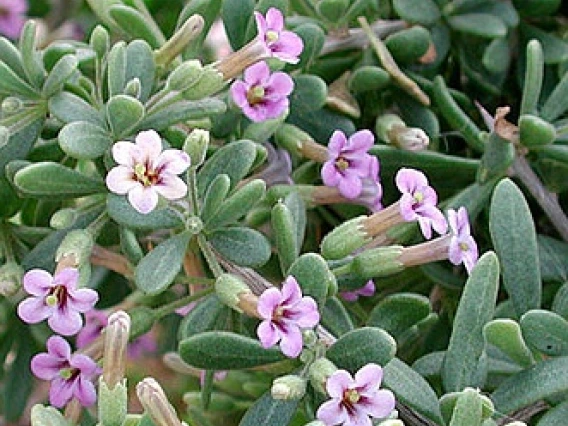


Botanical Name: Lycium fremontii
Common Names:
English: Wolfberry
Spanish: Tomatillo, fruitilla
O'odham: Kuáwul
Family: Solanaceae (nightshade)
Rain Garden Zone: L. fremontii thrives in the terrace Rain Garden Zone, but may also do well in the top and bottom zones. (2)

Reproduced with permission from "Rainwater Harvesting for Drylands and Beyond" by Brad Lancaster, HarvestingRainwater.com
Flowering Season: February - March; July --August
Harvest: March--April; August--September
Harvest Techniques: Wolfberries may be picked by hand, careful to avoid thorns. Wolfberries should be processed immediately as they are quite perishabele (2).
Planting Season: Plant with winter and summer rains
Landscape Cultivation: No seed scarification is necessary. Plant underneath mesquite or ironwood trees, as these are important nitrogen fixers and provide shade. L. fremontii grows well in well-drained soil, tolerating acidic to very alkaline conditions. (4, 5)
Characteristics: L. fremontii is considered a shrub with spreading to ascending branches, usually with thorns. Leaves are 10 to 25 mm long and narrowly ovate. The flowers are small and bell shaped, and give way to bright red berries with many small seeds. L. fremontii is drought deciduous with new leaves forming after rainfall. (4)
Ecology: Desert birds, such as quail and curve-billed thrasher, roost in the wolldberry foliage for warmth and protection from night predators. Animals feed on the berries and leaves, and hummingbirds and other pollinators consume nectar from the flowers.
Ethnobotany:
Food:
Wolfberries may be dried and used in granola, trail mix, and cereal. Fresh berries may be used in soups, stews, syrups, stuffing, and jams. Wolfberries are a great source of vitamins A, B2, and C, as well as calcium, potassium, iron, and zinc. They are highly valued for their antioxidant properties, as well as their benefits to eye health and weight loss.
Domestic Animals:
Chickens may feed on the fruit or leaves of the plant. Honeybees may also pollinate flowers and produce honey.
Other:
Wolfberries have traditionally been used medicinally, brewed into teas, tinctures, and syrups. Wolfberries are medicinally valuable for their high vitamin content, antioxidant properties, and benefits to eye health and weight loss. Additionally, wolfberries may be a mild pain-killer.
References:
- Desert Harvesters. (2018). Eat mesquite and more: a cookbook for Sonoran desert foods and living. Tucson, AZ. RainSource Press.
- Lancaster, B. (2006) Rainwater harvesting for drylands and beyond. Tucson, AZ. RainSource Press.
- https://ucjeps.berkeley.edu/cgi-bin/get_JM_treatment.pl?7625,7636,7644
- Nokes, J. (2001) How to grow native plants of Texas and the southwest. Austin, TX: University of Texas Press.
- https://pfaf.org/user/Plant.aspx?LatinName=Lycium+fremontii
For more information on this plant, see the Campus Arboretum species description pages.
Go to the next tour stop: catclaw acacia page or Return to the main Dunbar Spring tour page

